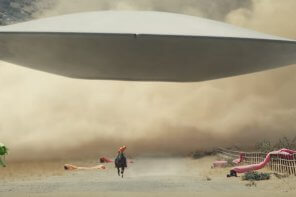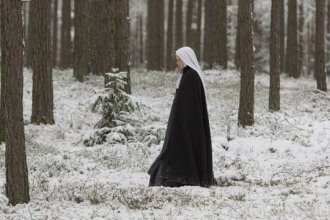In the past two years, actor Taylor Sheridan has quickly fashioned a new role for himself in Hollywood. A man known mostly for his work in police procedurals and Sons of Anarchy is now California’s cowboy auteur, a voice steeped in the bygone era of the classic Western.
I bring that up not because Sheridan’s work is explicitly classic Western. You won’t see many horse-riding, gun-toting cowboys. In his modern version of high noon, horses are swapped for armored SUV’s and pickup trucks; pistols for assault rifles. Instead, Sheridan’s films evoke the essence of Western: wide open spaces and clear-cut hardships of the affected peoples. And in each of Sheridan’s first two entries, he tackled heavily politicized people groups by putting boots and blood on the ground. His breakout, Sicario, explored the volatile and banal world of the U.S.-Mexico border while last year’s Oscar-nominated Hell or High Water weighed the relationship between disaffected Texas white people and traditional law enforcement. It’s the closest to John Wayne and cowboys he’s been in his short career behind the camera. Both films acted without moral compass, deeply calling into question our feelings of justice and vengeance in harsh and often brutal ways.
Sheridan’s third entry mirrors many elements of the first two. Wind River is just as wide open as its predecessors and, in the end, is just as brutal. But while the former films ask the audience to empathize, this one asks them to also listen and observe. It’s a subtle difference throughout, but one that becomes abrasively clear by the time it fades to black.
“This is the Land of, ‘You’re on Your Own’”
I don’t know about you, but I always forget that Wyoming exists. I apologize to any potential Wyoming residents reading this: it’s just that I’m a midwestern kid, so all my travel has been focused on getting to tropical beaches or foreign countries. A trip to the mountains is nice, but I’ve got North Carolina or Colorado for that. And it’s not that I’d be opposed to visiting, it’s just never been my first choice.
 I get the sense the residents of Wind River feel the same way, namely because many of them explicitly say it. Throughout the film, several characters talk about the thought or hope of getting off the Wind River Indian Reservation. Be it the cold, the crime or the lack of opportunity, Wind River feels like a trap, one you can’t escape no matter how far or hard you run. The metaphors representing this idea are better shown than said; the movie’s more effective moments come in scenes of high and sudden drama rather than long discourse. It’s a hallmark Sheridan has built early in his career, and you get the sense he’s trying to shake it here. Still, the message comes through: not many people want to be in Wind River, but everyone seems to recognize the perils of trying to leave.
I get the sense the residents of Wind River feel the same way, namely because many of them explicitly say it. Throughout the film, several characters talk about the thought or hope of getting off the Wind River Indian Reservation. Be it the cold, the crime or the lack of opportunity, Wind River feels like a trap, one you can’t escape no matter how far or hard you run. The metaphors representing this idea are better shown than said; the movie’s more effective moments come in scenes of high and sudden drama rather than long discourse. It’s a hallmark Sheridan has built early in his career, and you get the sense he’s trying to shake it here. Still, the message comes through: not many people want to be in Wind River, but everyone seems to recognize the perils of trying to leave.
This sense of isolation and grim cynicism is what turns Wind River into a tight, gripping thriller. In the opening of each door and the turn into every hallway, you get the sense that any mistake is fatal simply because no one is coming to pick up your slack. When Agent Jane Banner – Elizabeth Olsen turning in an admirable performance out of her comfort zone – guns down a criminal, she calls the sheriff for EMS. The sheriff, a native, instead watches the life leave the young man, despite her frequent calls to do otherwise.
The isolation also allows Sheridan to explore the more real-world issue of Native American reservations on a personal level. I’ll expound more shortly, but the above scene is a stunning look into the local law enforcement mindset. It shows through all the more clearly in Cory Lambert’s – a reliable leading-man turn from Jeremy Renner – conversation with a murdered girl’s junkie brother. The young man sits in the back of a squad vehicle, resigned to his future. “Going to jail’s almost a badge of honor,” the sheriff says in one way or the other. Renner pulls much-needed information out of him by appealing to his dreams outside the reservation. Didn’t he ever want to be something other than a criminal or a drug user?
Of course, says the young native. But the reservation: “It takes and it takes.”
“So What Did You Take?”
The symbolism of “taking” is pretty heavy-handed throughout the film, particularly in an otherwise brilliant third act. Of course, Sheridan’s trying to turn the idea of Manifest Destiny on its head. The idea that unwanted land is draining the life from an already displaced people is crushing and could sometimes use a bit more subtlety.
 But I’m also of the opinion that heavy-handedness is OK when speaking to an unrepentant grievance. In perhaps the scene’s most powerful scene, Agent Banner visits the home of the murdered teenager, seeking to do a job that she’s been clear she doesn’t feel qualified to do. When speaking to the girl’s father, she hurls micro-aggressions and condescension, earning his ire. “ Why is it that whenever you people try to help us, you always insult us first,” he declares. The phrase “you people” is loaded, particularly across racial lines. It’s also striking when in the next minute the same man is hysterically weeping into another white person’s arms. It makes sense though. Olsen’s Agent Banner is an outsider, another reminder of the outside world that seems like an impossible escape. Meanwhile, Renner’s Lambert is a man of the reservation, not because of his ethnicity, but because of his shared experiences.
But I’m also of the opinion that heavy-handedness is OK when speaking to an unrepentant grievance. In perhaps the scene’s most powerful scene, Agent Banner visits the home of the murdered teenager, seeking to do a job that she’s been clear she doesn’t feel qualified to do. When speaking to the girl’s father, she hurls micro-aggressions and condescension, earning his ire. “ Why is it that whenever you people try to help us, you always insult us first,” he declares. The phrase “you people” is loaded, particularly across racial lines. It’s also striking when in the next minute the same man is hysterically weeping into another white person’s arms. It makes sense though. Olsen’s Agent Banner is an outsider, another reminder of the outside world that seems like an impossible escape. Meanwhile, Renner’s Lambert is a man of the reservation, not because of his ethnicity, but because of his shared experiences.
The distinction is striking. And while I’m tempted to be bothered by the notion of Renner as a white savior on a native reservation, I’m also comforted to know that he’s not saving anyone other than himself in the end. He later reminds Agent Banner that luck doesn’t exist on the reservation. If you want to survive, you learn to fight: for your sanity and against your grief.
I walked out of the movie wanting to know more and to have more conversations about the topic of reservations. Sheridan’s efforts here may not be the most artful at times, but they’re effective if that’s the attitude his film creates.
The Issue of Hope
I’ve lately been thinking a lot about the narrative need for hope, specifically when it comes to film. I’m all for watching heavier movies, but cold narcissism misrepresents the world as I understand it. And that’s a criticism I’ve heard about Sheridan’s films from some people. They’re too cold and violent and unflinching when staring into the darkness of humanity.
 I felt that way sometimes while watching Wind River. It’s not his most violent or shocking film, but it does linger more than either of his previous two. The questions he raises are beyond any resolution he could draw up in 2 hours or any that we’ve seen in more than 200 years. But I will say the film’s final 10 minutes are highly redemptive; the last scene is particularly touching.
I felt that way sometimes while watching Wind River. It’s not his most violent or shocking film, but it does linger more than either of his previous two. The questions he raises are beyond any resolution he could draw up in 2 hours or any that we’ve seen in more than 200 years. But I will say the film’s final 10 minutes are highly redemptive; the last scene is particularly touching.
Two men sit together, reflecting on the way their lives have gone, the weight of their now-shared history heavy in the air. One asks the other if they can sit together a little longer. The other replies, he isn’t going anywhere. It’s here where Wind River finds its heart and, ultimately, its saving grace.
While there are no particularly religious overtones in Wind River, you can almost call this scene – and others like it – a type of church. It’s not in a building or a home. And it’s certainly not in the wilderness none of them asked to be trapped in. Instead, it’s found in the connections the characters build with each other and the burdens they share. There’s a quiet sort of elevation in the promise of shared struggle, one that can warm even the coldest of Wyoming nights.





